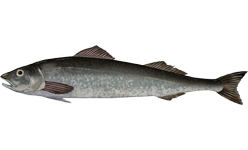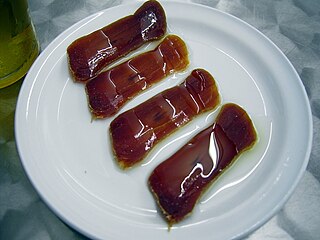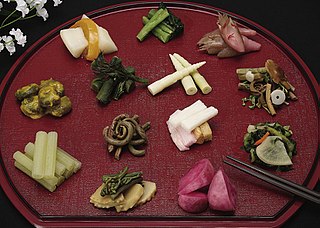
Miso is a traditional Japanese seasoning. It is a thick paste produced by fermenting soybeans with salt and kōji and sometimes rice, barley, seaweed, or other ingredients. It is used for sauces and spreads, pickling vegetables, fish, or meats, and mixing with dashi soup stock to serve as miso soup, a Japanese culinary staple. Miso is high in protein and rich in vitamins and minerals, and it played an important nutritional role in feudal Japan. Miso is still widely used in both traditional and modern cooking in Japan and has been gaining worldwide interest.

Sashimi is a Japanese delicacy consisting of fresh raw fish or meat sliced into thin pieces and often eaten with soy sauce.

The sablefish is one of two members of the fish family Anoplopomatidae and the only species in the genus Anoplopoma. In English, common names for it include sable (US), butterfish (US), black cod, blue cod (UK), bluefish (UK), candlefish (UK), coal cod (UK), snowfish, coalfish (Canada), beshow, and skil (Canada), although many of these names also refer to other, unrelated, species. The US Food and Drug Administration accepts only "sablefish" as the acceptable market name in the United States; "black cod" is considered a vernacular (regional) name and should not be used as a statement of identity for this species. The sablefish is found in muddy sea beds in the North Pacific Ocean at depths of 300 to 2,700 m and is commercially important to Japan.

The yellowfin tuna is a species of tuna found in pelagic waters of tropical and subtropical oceans worldwide.
The ayu sweetfish, ayu or sweetfish, is a species of fish. It is the only species in the genus Plecoglossus and family Plecoglossidae. It is a relative of the smelts and other fish in the order Osmeriformes.
Sauries are fish of the family Scomberesocidae. There are two genera, each containing two species. The name Scomberesocidae is derived from scomber and the Latin esox meaning pike.

The largehead hairtail or beltfish is a member of the cutlassfish family, Trichiuridae. This common to abundant species is found in tropical and temperate oceans throughout the world. The taxonomy is not fully resolved, and the Atlantic, East Pacific and Northwest Pacific populations are also known as Atlantic cutlassfish, Pacific cutlassfish and Japanese cutlassfish, respectively. This predatory, elongated fish supports major fisheries.

Mojama is a Mediterranean delicacy consisting of filleted salt-cured tuna, typically found in the Murcia and Andalusia regions of Spain, particularly in Huelva and Cádiz or in Portugal in the region of Algarve. Bluefin or yellowfin tuna are the most common varieties used.

Fresh fish rapidly deteriorates unless some way can be found to preserve it. Drying is a method of food preservation that works by removing water from the food, which inhibits the growth of microorganisms. Open air drying using sun and wind has been practiced since ancient times to preserve food. Water is usually removed by evaporation but, in the case of freeze-drying, food is first frozen and then the water is removed by sublimation. Bacteria, yeasts and molds need the water in the food to grow, and drying effectively prevents them from surviving in the food.

Japanese cuisine has a vast array of regional specialities known as kyōdo ryōri (郷土料理) in Japanese, many of them originating from dishes prepared using local ingredients and traditional recipes.

In Japan, it is customary to serve alcoholic drinks with snacks called sakana, shukō, or otsumami (お摘み). These are usually quite salty and served in relatively small portions. Sakana are usually more substantial than tapas, although they are not considered a meal since they are not accompanied by rice. Traditionally, the Japanese regarded sake, which is made from rice, as a substitute for white rice served in a standard Japanese meal, and as a result some Japanese do not eat rice and drink alcohol simultaneously.
Blue-backed fish ; also referred to as Blue-fish is a category of fish used in Japanese cuisine that have a rich and fatty taste, and are distinguished from another category of white meat fish that tend to have a lighter and more delicate flavor. It is not a scientific categorization, but refers to commonness in outer appearance, fleshiness and oiliness and include such species of fish as sardine, mackerel, herring, perch and anchovy. Blue-backed fish tend to be high in the essential amino acid, histidine, as well as the omega-3 fatty acids, eicosapentaenoic acid (EPA) and docosahexaenoic acid (DHA), and are generally said to have health benefits when included in a balanced diet, including such effects as reducing cholesterol.

Squid is eaten in many cuisines; in English, the culinary name calamari is often used for squid dishes. There are many ways to prepare and cook squid. Fried squid is common in the Mediterranean. In New Zealand, Australia, the United States, Canada, and South Africa, it is sold in fish and chip shops, and steakhouses. In Britain, it can be found in Mediterranean 'calamari' or Asian 'salt and pepper fried squid' forms in various establishments, often served as a bar snack, street food, or starter.

Sardines ("pilchards") are a nutrient-rich, small, oily fish widely consumed by humans and as forage fish by larger fish species, seabirds and marine mammals. Sardines are a source of omega-3 fatty acids. Sardines are often served in cans, but can also be eaten grilled, pickled, or smoked when fresh.

Anchovies are small, common saltwater forage fish in the family Engraulidae that are used as human food and fish bait. There are 144 species in 17 genera found in the Atlantic, Indian, and Pacific Oceans. Anchovies are usually classified as oily fish. They are small, green fish with blue reflections due to a silver longitudinal stripe that runs from the base of the caudal fin. They range from 2 centimetres (0.79 in) to 40 centimetres (16 in) in adult length, and the body shape is variable, with more slender fish in northern populations.

The Japanese sandfish, also known as the sailfin sandfish, is a species of fish of the Percomorpha (perch-like) clade in the order Trachiniformes, being one of the two genera in the family Trichodontidae, the sandfishes. Known in Japan as hatahata, it is a commercially important fish especially for Akita and Yamagata prefectures. Its habitat occurs in sandy-mud bottoms ranging from the Sea of Japan to the Okhotsk Sea.

Tsukemono are Japanese preserved vegetables. They are served with rice as an okazu, with drinks as an otsumami (snack), as an accompaniment to or garnish for meals, and as a course in the kaiseki portion of a Japanese tea ceremony.

Alaska pollock, a species of cod (Gadus) found in the North Pacific ocean, is used as food globally. Compared with common pollock, Alaska pollock is milder in taste, whiter in color, and lower in oil content.



























